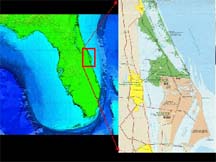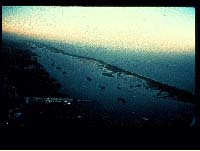Grant Gilmore
Aquatic Ecology and Fish Biology: Kennedy Space Center, Florida
The over 100 thousand acres of the Merritt Island National Wildlife Refuge and the Canaveral National Seashore offer unique combination of natural aquatic and terrestrial communities in association with a high technology setting, the NASA/Air Force space launch complex at Cape Canaveral, Florida.
|
 |
Biologists from throughout the United States and the world have been studying
organisms from wetland microbial communities to fiddler crab and terrapin
population dynamics. Physical oceanographers and climatologists have modeled
water and atmospheric conditions here and an internationally recognized
atmospheric CO2 impact research site is located in a Kennedy Space Center
(KSC) scrub oak community. Within this complex research community the
aquatic program is placing emphasis on using new NASA technologies such
as the Jet Propulsion Laboratory, Sensor Webs (Dr. Kevin Delin) and NASA
Kennedy Space Center developed Portable Acoustic Monitoring System (developed
by NASA’s Mike Lane and the Air Force’s Keith Sommer) to determine
hydrological and oceanographic conditions in association with underwater
biological activities, particularly those that produce sound, or acoustic
signals.
The overall objective is to place a variety of instrumentation in the
water that will allow investigators to continuously monitor climatic,
oceanographic conditions in association with biological activities such
as sound production. The correlation of sound production with procreation
(mating and spawning) as well as predation provides valuable information
on regional aquatic animal life histories, behavior and population dynamics.
The KSC study site is protected, representing one of the oldest Marine
Protected Areas within the continental United States. This allows instrumentation
deployment without human interference and vandalism. It also allows the
monitoring of natural fish and wildlife behavior without boating activity.
With the development of acoustic arrays, robust environmental and acoustic
sensor systems, extreme low light camera systems, and robotic platforms
(ROVs and AUVs), it will be possible to conduct a wide variety of environmental
and organismic observations and experiments to further understand aquatic
ecosystems which are inherently remote and difficult to study. Using acoustics
we will be able to study soniferous aquatic organisms, the over 30 species
of sound producers within the KSC, as well as the 197 soniferous fish
species occurring on the continental shelf adjacent to Cape Canaveral.
Passive (hydrophone arrays) and active (sonar) acoustic systems can tell
us not only where and when fish spawn, but also how many may be spawning.
Obviously, this has great implications for fisheries management as well
as our understanding of ocean creatures and their behavior in a dark alien
world.
 Spotted Seatrout |
As the sun settles along the western shore of the shallow subtropical Indian River Lagoon system in east central Florida, male spotted seatrout, red drum, weakfish and silver perch begin to migrate to spawning sites where they will call their mates for several hours in the evening darkness. Females join them to spawn and release gametes in the water column. All spawning is normally completed by midnight. During the early morning and the following day these waters are devoid of the deafening chorus of calls made the preceding evening. Daytime estuarine waters are silent by comparison. For millions of years, night after night this ageless procession and symphony has taken place below a seasonal lunar and solar clock, each species with its season to mate. This very interesting behavior has evolved so that the species can successfully reproduce and maintain its populations under the adversities of climate, predation and disease. It is our objective to study the intricacies of this behavior and relate it to environmental conditions, interactions with other organisms, competitors, prey and predators. To successfully pursue this difficult goal we must develop new technologies and methods of fish study. With integrated support from a variety of sources and collaboration with colleagues from around the world it is likely to succeed in opening the door to a new world and era of ocean exploration and understanding.

